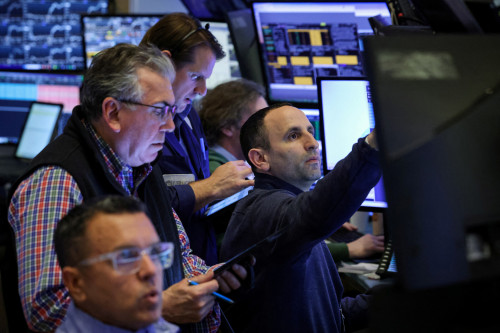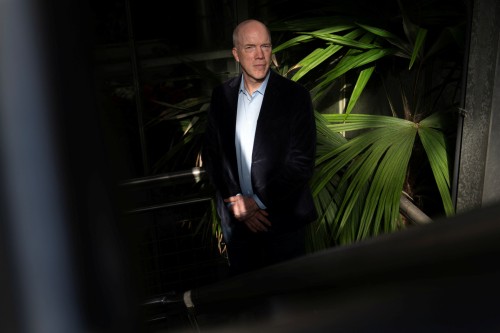By Jamie McGeever
ORLANDO, Florida (Reuters) – TRADING DAY
Making sense of the forces driving global markets
By Jamie McGeever, Markets Columnist
Trump blinks, Wall Street soars
Wall Street clocked one of its best days in history on Wednesday after President Donald Trump announced a 90-day pause on tariffs and reduced levies on many countries, triggering a wave of relief that will add trillions of dollars of lost value back onto world stocks.
It was the S&P 500’s best day since 2008 and the Nasdaq’s second-biggest rise on record, historic moves that will leave investors reeling. In a good way, for once. But it may be a fragile calm that sets in when the euphoria fades – tariffs on China were increased to 125%, and recent dislocation in the U.S. bond market is unlikely to disappear overnight.
More on all that below, but first, a round-up of the main market moves on another extraordinary day. I’d love to hear from you, so please reach out to me with comments at . You can also follow me at @ReutersJamie and @reutersjamie.bsky.social.
If you have more time to read today, here are a few articles I recommend to help you make sense of what happened in markets.
1. Wall Street bosses fear anti-American backlash asTrump’s trade war intensifies 2. Sharp US bond selloff revives flashbacks of COVID-era’dash-for-cash’ 3. Yuan may be cat among FX pigeons: Mike Dolan 4. China’s central bank asks state lenders to reduce dollarpurchases, sources say 5. Japan, Canada agree to cooperate on market stability
Today’s Key Market Moves
* The S&P 500 jumps 9.6%, the Nasdaq 12.2% and the Dow 7.8%after Trump’s tariff announcement. * It’s the S&P 500’s best day since 2008 and third-biggestgain since the 1930s; it is the Nasdaq’s biggest rise since 2001and second-largest on record. * Some $4 trillion is added to the S&P 500’s market cap. * The VIX index of implied volatility on Wall Streetregisters its biggest one-day decline ever. * All 10 sectors on the S&P 500 rip higher, led by a 12%surge in tech and 11% rise in consumer cyclicals. * Japanese stock futures point to a 10% rise at the open inTokyo, DAX futures are signaling a rise of 5% at the open inGermany. * Bitcoin leaps 8%. * The Aussie dollar rallies more than 3%, its biggest risesince 2011, and emerging market FX surge – the Mexican peso andBrazilian real rally 3% also. * A $39 billion auction of 10-year Treasuries draws soliddemand and a whopping 87.9% allocation to “indirect bidders”,often seen as a proxy for foreign central banks.
Boom! Trump tariff pause sparks monster rally
Vladimir Lenin doesn’t often figure in analysis of modern-day financial markets, but anyone trading or investing on Wednesday will know exactly what the Soviet revolutionary meant with his 1917 observation that: “There are decades where nothing happens; and there are weeks where decades happen.”
One week ago, U.S. President Donald Trump unveiled how much America will tariff imports of goods from dozens of countries around the world. His “Liberation Day” announcement sparked fears of global recession and a wave of turmoil that wiped trillions of dollars off the value of world markets.
Fast forward to this Wednesday, and Trump’s social media announcement that tariffs will be paused for 90 days and reduced for most countries to 10% unleashed a feeding frenzy on Wall Street that has rarely been seen. Ever.
Treasury Secretary Scott Bessent said the administration needed time to negotiate with more than 75 countries that had reached out, and suggested Trump had used the tariffs to create “maximum negotiating leverage for himself”. Trump himself told reporters it was a “good” day on the stock market and the bond market is now “beautiful”.
It wasn’t all beautiful, however. Trump escalated the trade war with China, raising tariffs to 125% due to “the lack of respect that China has shown to the World’s Markets”. It’s a move that could trigger a response in kind from officials in Beijing who have already vowed “to fight to the end”.
Before Trump’s bombshell, China’s offshore yuan had tumbled to a record low 7.4287 per dollar, the onshore yuan was nudging 7.35 per dollar and lows last seen in 2007, and the central bank’s daily fixing was the weakest since September 2023.
Some of that pressure should now lift as part of the global relief rally. But ultimately, Sino-U.S. trade tensions have intensified and China’s options in the face of 125% U.S. tariffs are limited – it may yet opt to allow the yuan to devalue.
But the mood across world markets is suddenly a whole lot brighter. The scale of the rally triggered by Trump’s retreat is a reminder of just how gloomy sentiment was only a few hours earlier. It will be fascinating to see whether Wednesday April 9 really is a turning point from Wednesday April 2.
Creaking U.S. bond market signals danger still lurks
Global markets are breathing a huge sigh of relief following U.S. president Donald Trump’s surprise announcement of a 90-day hiatus in much of his tariff agenda, but it would be premature to think the dangers posed by the U.S. bond market dysfunction this week have suddenly disappeared.
When financial crises migrate to Treasuries, regulators start to get very nervous, as stress here can lead to large, rapid shifts in prices that suddenly clog up market ‘plumbing’ and inhibit its functioning, requiring the Federal Reserve to step in.
And cracks started to appear this week in the $29 trillion Treasury market, the bedrock of the global financial system and the benchmark for trillions of dollars of loans globally, as investors dumped huge amounts of long-dated bonds.
The moves in Treasuries and swap spreads were extraordinary, in some cases historic. The 30-year swap spread briefly widened through -100 basis points on Tuesday, its most negative since the pandemic. The 10-year yield at one point was up more than 40 bps and on course for its biggest weekly rise since 2001. And the 30-year yield gapped up 60 bps, on track for its biggest weekly rise since 1981.
These moves were not reflective of a liquid, well-functioning market, especially as they came in a deep ‘risk off’ environment, which should, in theory, have been spurring huge safe-haven inflows.
Indeed, the speed and scale of liquidation in the scramble to raise cash, limit losses and meet margin calls had echoes of the early days of the pandemic crisis five years ago. Tensions had cooled a bit even before Trump’s announcement on Wednesday, but yields remain elevated, and the trade war is far from over – just ask China – so these bond tremors could easily erupt again.
MARKET FUNCTIONING
Federal Reserve officials will thus continue to watch keenly for any warning signs of danger ahead, including evaporating liquidity, plummeting demand, widening bid-offer spreads and ‘gapping’ yields in certain parts of the curve.
The Fed will be on the lookout for a ‘buyers’ strike’, whether that’s domestic or foreign investors, something that may have been brewing this week before Trump’s tariff surprise. Bank of America’s Meghan Swiber warned earlier on Wednesday that further deleveraging and liquidation risked a downward spiral that could only be halted by official intervention.
What would the Fed’s options be in this scenario? Interest rate cuts would be highly unlikely, as they would not be especially helpful in resolving a market dislocation issue.
The central bank has amassed an array of liquidity backstops and lending facilities since 2008, such as the overnight reverse repo program, standing repo facility, dollar swap lines with foreign central banks, and the discount window. These tools could all be sharpened, deployed or extended as policymakers see fit.
The Fed could also announce a temporary or permanent exemption for Treasuries in banks’ Supplementary Leverage Ratio calculations, which would ease bond market strains and encourage banks to keep the lending taps open. It could also end its balance sheet runoff, or quantitative tightening program, earlier than planned.
And in extremis, if the market really froze like it did in 2020 and 2008, the Fed could go full circle and start buying bonds again.
That’s the ultimate bazooka, which the Fed will be loath to dust down and fire. It would prefer not to be called upon at all, and maybe Trump’s tariff pause means it won’t have to. But more volatile weeks like this one in Treasuries, and it may have no choice.
What could move markets tomorrow?
* China PPI and CPI inflation (March) * U.S. CPI inflation (March) * U.S. 30-year Treasury bond auction * Seven Fed officials scheduled to speak at various eventsand locations
Opinions expressed are those of the author. They do not reflect the views of Reuters News, which, under the Trust Principles, is committed to integrity, independence, and freedom from bias.
Trading Day is also sent by email every weekday morning. Think your friend or colleague should know about us? Forward this newsletter to them. They can also sign up here.
(By Jamie McGeever, editing by Nia Williams)





